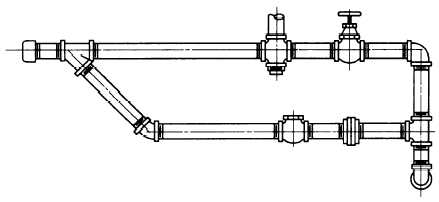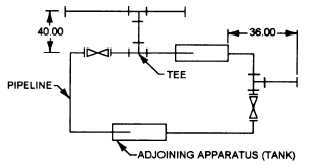CHAPTER 5
PIPING SYSTEMS
When you have read and understood this chapter,
you should be able to answer the following learning
objectives:
Interpret piping blueprints.
Identify shipboard hydraulic and plumbing
blueprints.
PIPING DRAWINGS
Water was at one time the only important fluid that
was moved from one point to another in pipes. Today
almost every conceivable fluid is handled in pipes
during its production, processing, transportation, and
use. The age of atomic energy and rocket power has
added fluids such as liquid metals, oxygen, and
nitrogen to the list of more common fluids such as oil,
Figure 5-1.—Single-line orthographic pipe drawing.
water, gases, and acids that are being carried in piping
systems today. Piping is also used as a structural
element in columns and handrails. For these reasons,
drafters and engineers should become familiar with
pipe drawings.
Piping drawings show the size and location of
pipes, fittings, and valves. A set of symbols has been
developed to identify these features on drawings. We
will show and explain the symbols later in this chapter.
Two methods of projection used in pipe drawings
are orthographic and isometric (pictorial). Chapter 3
has a general description of these methods and the
following paragraphs explain their use in pipe
drawings.
ORTHOGRAPHIC PIPE DRAWINGS
Single- and double-line orthographic pipe
drawings (fig. 5-1 and 5-2) are recommended for
showing single pipes either straight or bent in one
plane only. This method also may be used for more
complicated piping systems.
ISOMETRIC (PICTORIAL) PIPE
DRAWINGS
Pictorial projection is used for all pipes bent in
more than one plane, and for assembly and layout
work. The finished drawing is easier to understand in
the pictorial format.
Figure 5-2.—Double-line orthographic pipe drawing.
5-1



